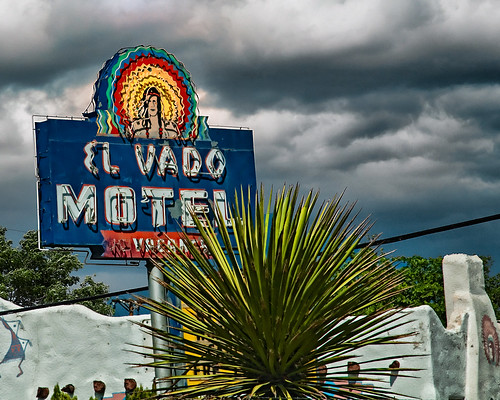
A developer has been picked by the city of Albuquerque to redevelop the historic El Vado Motel — including it being partly revived as a boutique motel, according to Albuquerque Business First.
Palindrome Communities is the developer, which is a partnership between PacifiCap and the Sawmill Community Land Trust.
Its proposal calls for creating a community food court, an amphitheater, a boutique motel and a small events center on the El Vado portion of the site.
The adjoining Casa Grande portion of the site will include 60 units of workforce housing, the city said.
Redevelopment costs are estimated at $15.9 million, according to the city.
Groundbreaking is planned for 2016.
Here is KRQE-TV’s report about the developer, which includes artist’s renderings of the completed project:
The Albuquerque Journal has a few more details about the redevelopment, including an artist’s rendering of the overall plan. It appears the boutique motel will be in the back half of the motel, and the front half will be the food courts.
Irish immigrant Daniel Murphy opened El Vado Auto Court Motel on Route 66 in 1937. It’s cited as one of the best examples of pre-World War II motels in New Mexico. It was listed on the National Register of Historic Places in 1993.
El Vado closed in 2005 after new owner Richard Gonzales said he wanted to bulldoze it for luxury townhouses. The city seized the property a few years later after a long fight to save it.
A few purists will quibble about El Vado being redveloped into other purposes. However, adaptive reuse often is advocated by the Route 66 Corridor Preservation Program as a way to keep historic properties. And Albuquerque’s Route 66 corridor has such a glut of motels, keeping El Vado as just a lodging establishment would be a very doubtful proposition. Having this motel used in multiple ways probably is the best and most viable option.
(Image of El Vado Motel sign by Pete Zarria via Flickr)
I wonder, just like trying to figure out the road limit for Route 66 Hall of Fames of Visitor Centers, what the line is for Route 66 era commercial design/buildings being designed/built into some sort of third dimension of overloaded concepts.
All of these rebuilds, most financed with federal funds attached to money granted under various reuse laws (and, ironically, lots of them popping up in the great vastness of a key Republican States of America locale, Oklahoma) seem void of any real purpose. I mean that kindly, but wonder where this using federal funds to finance (or assist) basically a local business renovation with Route 66 as a ‘theme’ will eventually end up.
I’ve read the numbers that form the basis of claims that these projects always result in increased tourist spending, numbers that are used again down the road when another old, run down Route 66 era business(es) are being packaged by local investors as the best way to save/promote/advance their town. And so on.
Since Seligman, Arizona locals got behind Angel the Barber and fronted a true grass roots effort to ‘save’ the remains of Route 66 in their area, countless others after seeing Seligmans rebirth have been trying to ride the ‘wave’ of Route 66 tourism by advancing projects in their own areas. Some of those efforts have been true, grassroots in nature and focused on doing something positive for a town. They used to involved groups getting together to paint, clean, clear or promote areas. Now, most of these projects are driven by local developers piggybacking that very sense of the past and the old-days into money making without much sense feel for the real Route 66.
Today, as you drive west out of Chicago, it’s not long before you get examples of this duality of purpose. You’ll see a restored old 1920’s era gas station painted and cleaned up by grassroots in the state. Then, you start seeing the ‘projects’ where Route 66 is used as a marketing tool. The more you drive west the more you can see which group is winning the battle for how 66 will be remembered.
That’s kinda sad because 66 pretty much just popped up and evolved over time. It also died off and was nearly gone until Angel and the folks got involved. Now, if what we’re seeing time and time again all along the Route is any indication, the real ’66’ that Angel and his people fought to save might itself be on life support and is being replaced by the ‘repurposed’ design/build projects of wealthy developers flaunting access to federal funds to use the memory of 66 for personal gain. And profit.